The best recipes for sauerkraut with beets from around the world
Sauerkraut - a widely known dish, a source of vitamins and a means to support immunity on winter days. Recipes for sauerkraut are found not only in the national cuisine of Russia, but also in many countries of Europe and Asia.
Additional ingredients are often added to cabbage: vegetables (mainly carrot and beets, sometimes peppers), fruits (apples), berries (cranberries, lingonberries), which give the product a different taste and color. We’ll tell you in this article how to salt cabbage and beets in different ways.
Selection and preparation of main ingredients
Mid-season cabbage varieties are more suitable for pickling. Early varieties of the vegetable do not have a rich vitamin composition; late varieties have a bitter taste, less sugar and excessive hardness of the head of cabbage.
Interesting! The most delicious blanks are obtained from flat-rounded heads that are usually sweeter and juicier than other forms.
For preparations, choose a small but heavy fork, since the heaviness indicates the ripeness of the cabbage. The leaves of a vegetable suitable for fermentation should be fresh, juicy, soft and have a sweetish taste, and the head itself should be tight and slightly crunchy in your hands when squeezed.
The color of white cabbage leaves should be white, without greenery. You should not ferment cabbage whose leaves have been eaten by insects or have brown and black areas, indicating that the vegetable has been damaged by fungi and putrefactive bacteria.
Pay attention to the size of the stalk: as a rule, a wide stalk is quite short, and a narrow stalk, on the contrary, will be long.
Other ingredients needed for cabbage starter:
- carrots are root vegetables of any size, the main thing is that they must be juicy and sweet, since dry and limp preparations will not produce tasty preparations;
- beets are a medium-sized root vegetable with a pronounced wine color;
- salt - food grade, coarsely ground.
Iodized salt is not suitable for preparations, as it gives the dish a specific taste and reduces its shelf life. storage.
Why are beets in the recipe, what do they give?
From the point of view of food technology, sauerkraut is a product of lactic acid fermentation. It is rich in vitamins A, B and C, has a positive effect on digestion, helps normalize and maintain intestinal microflora. But at the same time, the dish is contraindicated for peptic ulcers of the stomach and duodenum.
A close analogue is pickled beets. When processed, all the beneficial properties of the raw root vegetable are preserved, in particular, beneficial acids (citric, tartaric and malic), vitamins A, B (B1, B2, B9), C, E, PP, beta-carotene, potassium remain unchanged. and phosphorus. Beets are low in calories and contain a lot of fiber.
In addition to giving the products a delicate color and unusual taste, beets enhance the positive effects of the product on health and immunity.
How to cook sauerkraut with beets
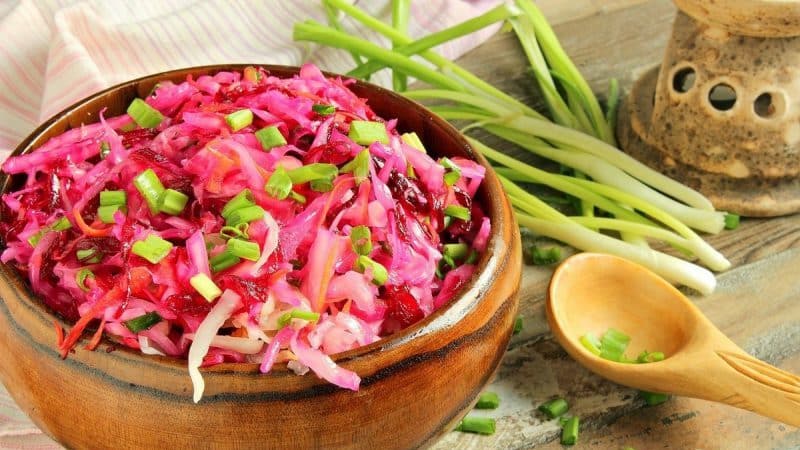
There is no “classic” recipe for sauerkraut with beets: each housewife, based on her preferences, varies the amount of main ingredients and the composition of additional ones.
Here is a recipe with a minimum set of products.
Ingredients:
- cabbage - 1 kg;
- beets - 0.5 kg;
- salt - 2 tbsp. l.
How to pickle:
- The cabbage is chopped, the beets are grated on a medium grater, everything is placed in a pan of suitable volume, covered with salt and mixed.
- Place a plate with a weight (a bottle of water) on top of the mixture.
- After 3 days, a crispy and colorful product is obtained. The vegetables are mixed again, placed in jars, compacted and covered with lids (nylon can be used).
The snack is stored in the refrigerator or cold cellar.
Recipe Variations
There are many varieties of sauerkraut and beetroot appetizers, each of which has its own composition of ingredients and taste characteristics.
Sauerkraut with beets in large pieces
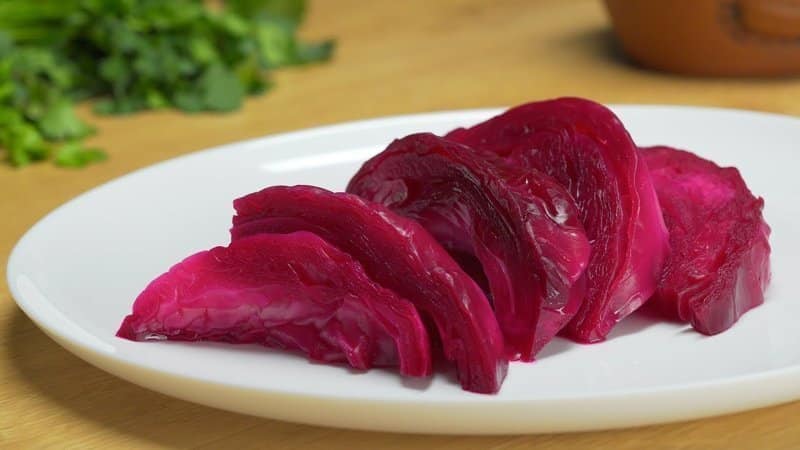
Ingredients:
- white cabbage - 2 kg;
- beets - 2 medium root vegetables;
- carrots - 2 medium root vegetables;
- garlic - 4 small cloves;
- chili pepper - ¼ pod;
- water - 1.5-2 l;
- salt - 3 tbsp. l.;
- other spices to taste.
Preparation:
- Beets, cabbage and carrots are crushed to the same size pieces. Garlic and pepper are finely chopped.
- The vegetables, alternating, are immediately poured into the jar and garlic and pepper are placed between the layers in any order.
- Then prepare the marinade - add salt to water at room temperature and stir until completely dissolved. The solution should taste a little saltier than regular soup.
- Vegetables in a jar are poured with marinade “under the neck” and pierced with a wooden skewer so that the brine penetrates to the very bottom of the preparation. If necessary, add marinade.
- The jar is placed in a bowl into which excess liquid will drain, and placed in a warm place.
It takes 3-5 days for the preparation to be ready, while the vegetables in the jar are pierced at least 2-3 times a day, and starting from the 3rd day they are tasted. The finished snack is covered with a lid and placed in the cold.
In Georgian or Gurian
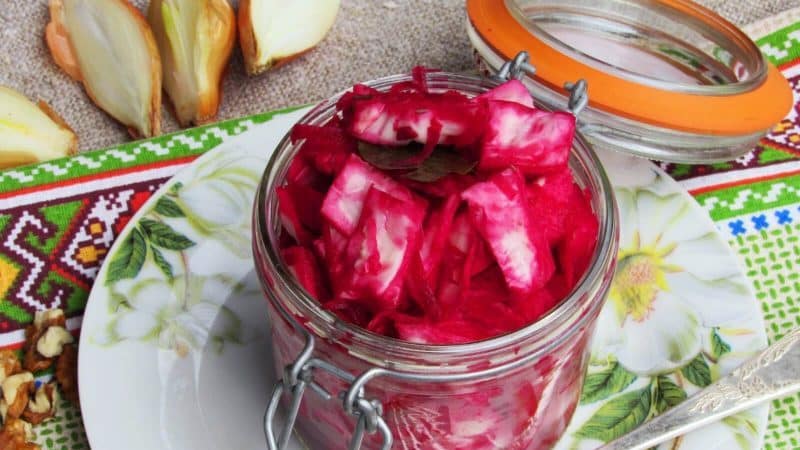
Ingredients:
- cabbage - 2 medium forks;
- beets - 4 medium root vegetables;
- garlic - 2 large heads;
- hot pepper (red) - 1 large pod;
- salt - 1 tsp.
Brine:
- water - 2 l;
- salt - 2.5 tbsp. l. (with top);
- celery leaves and stalks - 1 bunch (100-130 g);
- black and allspice - a few peas;
- bay leaf - 2 pcs.
Preparation:
- The cabbage is cut into equal pieces along with part of the stalk and blanched in boiling water with salt for about 3 minutes.
- The beets are thinly sliced into slices, the peppers are seeded and chopped, the garlic is cut or passed through a press.
- The slices are placed tightly in jars, alternating layers of vegetables.
- All brine ingredients are mixed and brought to a boil.
- Hot brine is poured into jars filled with vegetables, and greens from the brine are placed under the neck of the jars.
- The jars are covered with lids and placed in a warm place for 2-4 days.
The finished snack is placed in the cold.
In Armenian
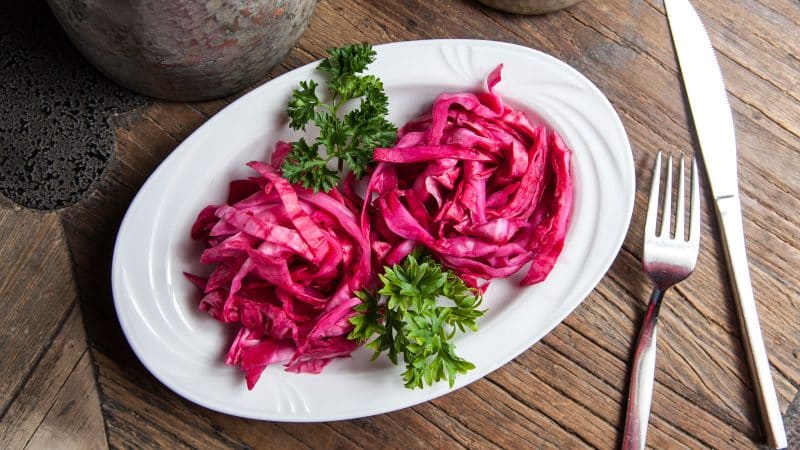
Ingredients:
- cabbage - 3 kg;
- carrots - 0.7 kg;
- beets - 0.5 kg;
- greens - a bunch;
- garlic - 1 pc.;
- pepper - 3-4 pods;
- cherry leaves - 150 g;
- bay leaf - 5-6 pcs.;
- salt - 3 tbsp. l.;
- cinnamon - 3-4 g;
- water - 1 l.
Preparation:
- Pepper, salt, bay leaf, cinnamon are poured into boiling water, everything is boiled for 1-2 minutes, after which the brine is cooled.
- Cabbage leaves are cut into 2-4 parts, garlic is peeled and divided into cloves, carrots are cut into slices, beets are cut into slices, peppers are peeled.
- All ingredients are laid out in a barrel in layers: cherry and cabbage leaves on the bottom, then chopped cabbage, then the rest of the ingredients (carrots, beets, garlic, herbs, peppers).
- Layers of cabbage and other ingredients alternate until they are completely used.
- Everything is compacted tightly.
- Cabbage leaves are placed on top, the workpiece is filled with brine, which should cover the vegetables by 4-7 cm.
- The barrel is covered with a cloth and a load is placed on top.
The barrel is stored at room temperature for five days, after which it is put into the cold.
In Korean
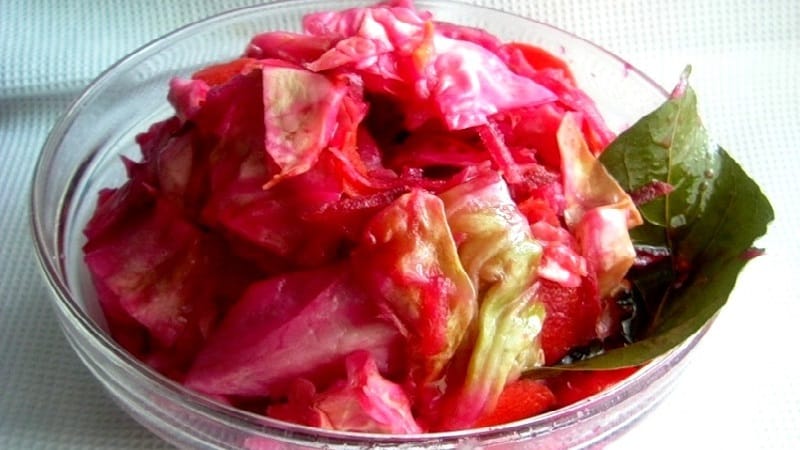
Ingredients:
- white cabbage - 1 head;
- beets - 1-2 pcs. medium root vegetables;
- garlic - 3-5 cloves;
- onion - 1 pc.
Marinade:
- water - 1 l;
- salt - 2 tbsp. l.;
- sugar - ½ cup;
- vegetable oil - ½ cup;
- vinegar 9% - 30-40 ml;
- bay leaf - 2 pcs.;
- black pepper - 4-6 peas.
Preparation:
- Cabbage is cut into squares measuring 2x2 cm.
- Beets are cut into strips or grated.
- The garlic is finely chopped or passed through a press, the onion is peeled and cut into cubes or half rings.
- All ingredients are mixed in a saucepan.
- Prepare the marinade - place all ingredients (except vinegar) into boiling water and boil for 5-10 minutes. Then vinegar is added.
- Vegetables in a saucepan are poured with hot marinade.
- The pan with the preparation is left at room temperature for 7-9 hours, after which it is put in the refrigerator for 7-9 hours.
Without vinegar “Like grandma’s”
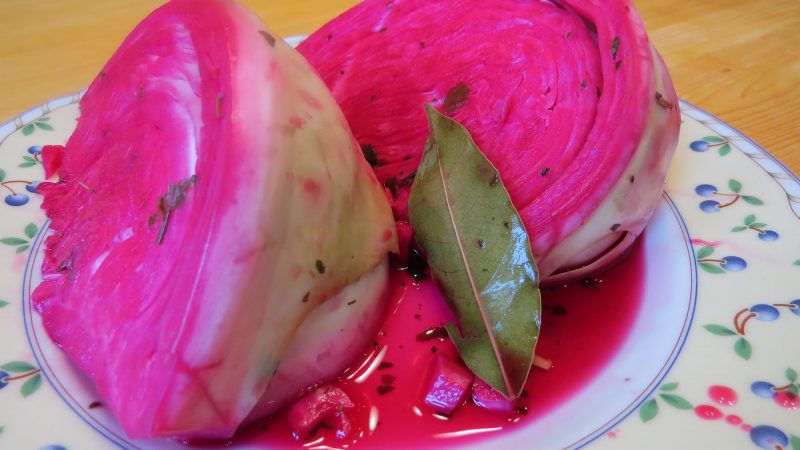
Ingredients:
- white cabbage - 5 kg;
- beets - 350 g (2-3 medium-sized pieces);
- carrots - 300 g (2-3 medium-sized pieces);
- garlic - 1 large head;
- chili pepper - 1 large pod;
- black bread “Borodinsky” - 100 g (optional).
Brine:
- water - 2.5 l;
- sugar - ½ cup;
- salt - ½ cup;
- allspice - 10-13 pcs.;
- cloves - 3-4 pcs.;
- bay leaf - 2-5 pcs.;
- spices (black peppercorns, cumin, cumin, etc.) - to taste, but not more than ¼ tsp.
Preparation:
- All brine ingredients are boiled for 3 minutes, stirring constantly. The finished brine is cooled.
- Cabbage is cut into medium pieces and lightly squeezed. Beets and carrots are grated on a coarse grater. The garlic is finely chopped or passed through a press. The pepper is chopped.
- All ingredients are placed in a saucepan: pieces of bread are placed on the bottom, covered with a layer of gauze, followed by squeezed cabbage, then garlic, pepper, and beets and carrots on the very top.
- Pour brine over everything so that the liquid does not completely cover the mixture - the vegetables will give juice within a few hours.
- Place pressure on top: a plate and a bottle of water (4-5 l).
The pan is placed in a warm place for 4-6 days. Several times a day, vegetables are pierced with wooden sticks. In the middle of the process, viscosity may appear, which will soon disappear.
Important! Readiness will be checked from the end of the second day. As soon as the preparation has acquired the desired taste, it is transferred to jars, but without bread.
Jars tightly closed with lids are stored in the cold.
Terms and conditions of storage
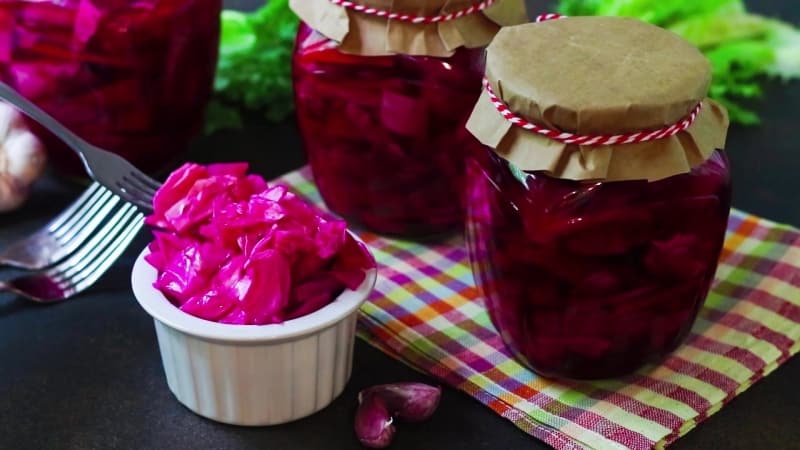
The finished appetizer of sauerkraut and beets is stored exclusively in the refrigerator at a temperature of +1...+5°C. If the temperature is higher, the fermentation process will continue and the taste of the product will change.
If necessary, the preparations are placed into portioned bags and frozen. The shelf life of frozen salad reaches 7-8 months. This preparation is ideal for making soups and salads.
Important! Sauerkraut and beets cannot be re-frozen.
Snacks are stored in closed glass jars with a sufficient amount of brine; the shelf life of such preparations in the refrigerator reaches 1.5-2 months.
In open containers and in plastic containers without freezing, the snack can be stored for no more than a week.
Advice from experienced housewives
Sometimes when storing blanks in a cellar or basement, a fungus appears on them - a white coating. You cannot eat such a salad; it is permissible to use it exclusively for making soup, after removing the coating first.
To avoid plaque, when sauerkraut is sauerkraut, add sour berries - lingonberries or cranberries. You can also sprinkle the surface of the cabbage with granulated sugar, dry mustard or grated root. horseradish.
Attention! During storage, the brine must cover the vegetables completely, otherwise the top layer will darken and become unsuitable for consumption. If there is not enough brine, you should add it.
The shelf life will be longer if you carefully pour a layer of vegetable oil on top of the salad and close it with a lid.
Conclusion
Sauerkraut with beets in cold weather will support the immune system and diversify the winter menu, and its preparation does not take much time. Classic pickling recipes will suit the busiest housewives, while gourmets will appreciate Georgian and Korean recipes.